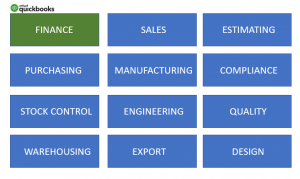 QuickBooks is, without doubt, the most successful SME financial accounting system in the world today, with over 2.5 million subscriber customers around the globe, widely used across every industry.
QuickBooks is, without doubt, the most successful SME financial accounting system in the world today, with over 2.5 million subscriber customers around the globe, widely used across every industry.
And therein lies its weakness.
As a standardized accounting system, it does exactly ‘what it says on the tin’, and it does it very well; it automates the financial accounting of a business. But that is all it does. It is not intended to be an enterprise wide integrated business system (ERP system).
So, for SME businesses that have a major operational side to their business, it is both a solution and a problem.
Take for example businesses that make, buy or sell ‘stuff’. Managing, handling and processing stock is their business. Accounting for it is an important, but small part of their overall business operation.

For many, the answer is spreadsheets; for others it is specific departmental or ‘point’ solutions, some choose to work a traditional ERP system. Most thankfully have moved on from pen and paper.
Let’s look at each in turn.

By the way, it is not just SMEs that have strong reliance on spreadsheets. One of the US’s major food companies (that I have worked with) has a ‘back office’ legacy ERP system. Legacy being a polite way of saying ancient. And as that was and is inflexible, it long ago stopped being relevant to the changing market demands the business was facing, and so spreadsheets became the local departmental solution used to process and analyze data. The business now essentially runs on 900 spreadsheets, creating local agility and corporate chaos. Needless to say, they, like many others, are looking at changing.
Departmental or ‘Point’ Solutions – these are specific departmental systems that are implemented to solve a local solution, i.e., SalesForce for CRM (Customer Relationship Management) helps in the sales office. A specific Estimating solution being us in the design office. And these are fine, solving a short-term problem at a time of need. But they create the same dilemma as spreadsheets. These created ‘islands of automation’. Nowhere is there single over-arching view of the state of the business against which considered and effective decisions can be made.
Traditional ERP Systems – And there are many marketed at SME’s, and whilst on the face of it they will provide ‘one version of the truth’, they too have significant drawbacks. Firstly, they are not specifically designed to work with QuickBooks. They nearly always have their own built in financial package, which is seldom as good as QuickBooks (as finance is not their core function), hence why you have decided to link it back to QuickBooks. They will usually provide some interfacing with QuickBooks; you need to examine how strong the actual integration is. Providing the best QuickBooks integration is not the core function of these businesses, and so at best it is usually ‘adequate’. But the second and most major drawback of using traditional ERP systems in an SME is usually cost. Once you add up all the different charge elements (subscription, support, enhancement, hosting, etc.) it will come to a large number, too large for an SME. And don’t forget cost and disruption of the implementation itself. ERP implementations are not easy, and they have ‘bad press’ for a reason!
So, what to do? Well out of this void has grown a new range of software specifically designed to address this problem.
QuickBooks Inventory Operations.
A few companies have been formed to specifically build out the QuickBooks functionality for companies where ‘stock’ is the big issue.
They integrate seamlessly with QuickBooks, they make no attempt to build their own financial suite to complement their stock control functionality, they exist purely to offer QuickBooks and QuickBooks online customers a more complete inventory management and stock control solution.
They are NOT full blow ERP systems and as such do not suffer the implementation overhead. They can be installed in minutes and with some online training you can be up and running in a matter of hours.
As they create a single QuickBooks Inventory Operations environment, there is only one stock figure, there is only one version of the truth. Proper decisions can be made based on accurate and timely data. The barriers between the departments dissolve as local spreadsheets are ‘binned’, and at last your SME ‘stock centric’ business can operate as a homogenous business with unity and confidence.
And they are affordable, some as little as $40 per user per month.
And, as a rule, they give great customer service as they are singular and focused on the QuickBooks market. And for the resource constrained SME, great customers service is essential.
Who are they?
Well Google QuickBooks Inventory Operations and see who you find.
There is a world of solutions out there aimed at you, the QuickBooks customer who make, buys, or sells stuff.



